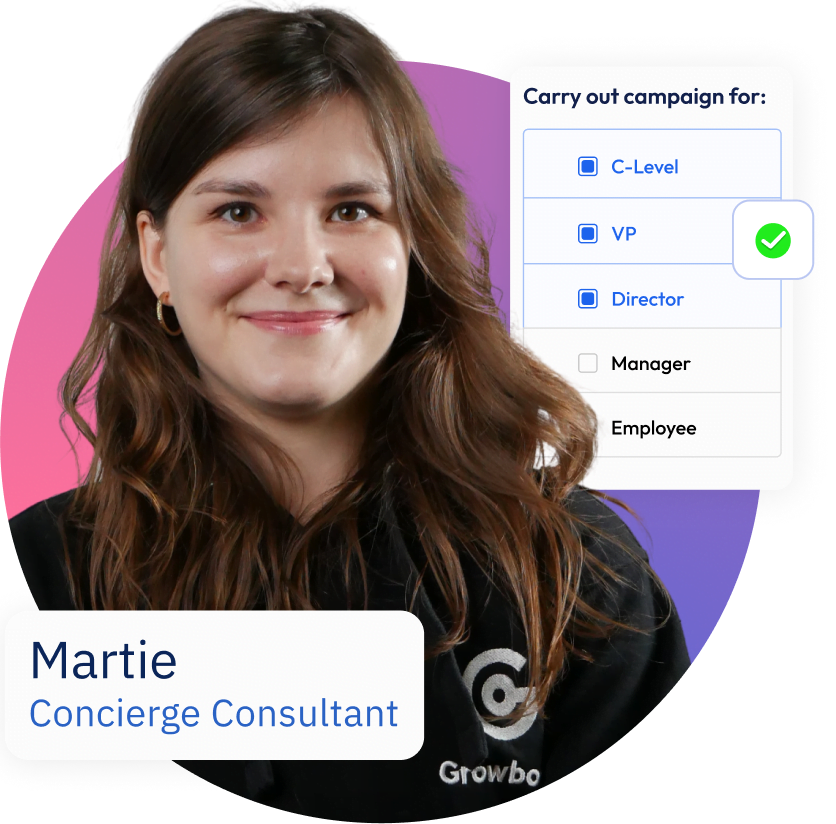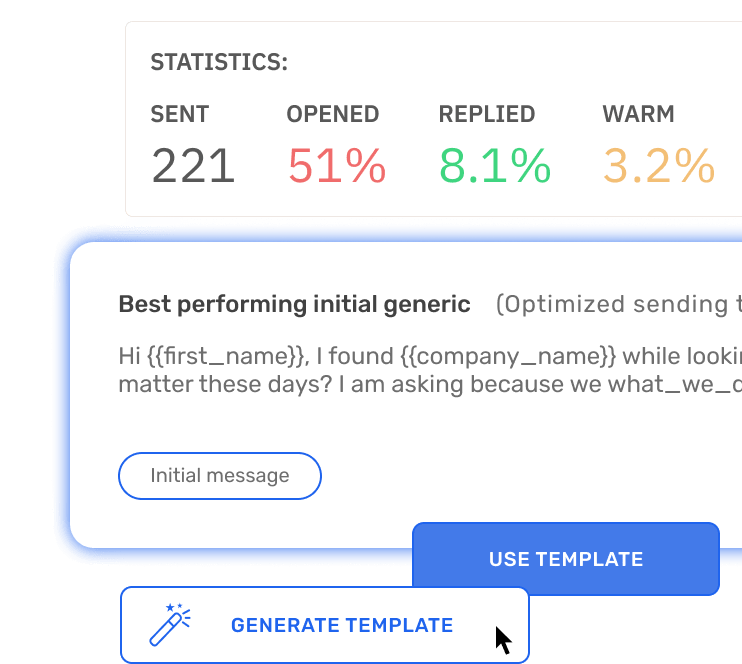Email outreach, with its direct line to potential clients, offers an unparalleled platform for personalized communication and targeted messaging. Here, the ‘call to action’ emerges as a pivotal tool, beckoning recipients towards a specific action—be it making a purchase, registering for a webinar, or simply clicking to learn more about a product. A strong CTA not only guides readers through the marketing funnel but also serves as a critical metric for gauging the success of email campaigns.
Understanding the nuances behind these stages empowers marketers and sales people to craft CTAs that resonate with their audience’s journey.
Through the employment of these principles, a CTA’s efficacy is markedly enhanced, yielding favorable outcomes for email campaigns.
Studies suggest that a CTA placed above the fold has a better chance of being clicked. However, context matters. For example, in a lengthy informational email, placing a CTA at the end might net better results as it follows the natural reading flow.
Using tools like Growbots’ analytics features, insights from these metrics can be gleaned to refine CTAs for optimal results.
Incorporating appropriate CTAs that match the expectations and buying behaviors of each segment leads to more targeted messaging and improved outcomes.
Understanding the preferences of the intended audience is essential in tailoring CTAs appropriately.
These practices align with ethical marketing standards and help maintain a positive brand reputation.
Key Takeaways
- Calls to action (CTAs) are essential in email outreach for guiding readers towards a desired action and serving as a metric for campaign success.
- The effectiveness of CTAs hinges on understanding the nuances of the marketing funnel and aligning CTAs with the stages of the buyer’s journey.
- Understanding consumer psychology, including creating a sense of urgency and scarcity, is fundamental in crafting compelling CTAs that drive action.
- Types of CTAs used in email marketing vary and include direct action, informational, social sharing, feedback, and personalized CTAs to cater to different campaign goals and audience interactions.
- Creating a compelling CTA copy involves using strong and actionable verbs, creating a sense of urgency, and focusing on highlighting the reader’s benefit.
- Placing CTAs strategically within an email ensures maximum visibility and interaction, with the “above the fold” area often recommended for primary CTAs.
- Measuring the success of CTAs is key to optimizing campaign effectiveness, with metrics such as click-through rate (CTR), conversion rates, and engagement providing valuable insights.
- Tailoring CTAs to the specific type of email, such as promotional, newsletter, or transactional emails, ensures that the messaging is appropriate and effective.
- Personalization significantly impacts the effectiveness of CTAs, with tailored messaging based on user behavior, purchase history, or demonstrated interests enhancing engagement and conversions.
- Crafting CTAs in B2B emails typically requires a formal tone and value-focused content, while B2C CTAs often rely on a more direct and emotionally driven approach for quick consumer actions.
- Incorporating CTAs into email subject lines can entice recipients to open emails if executed with enticing and clear language that reflects email content accurately.
- Advanced CTA strategies involve precise segmentation, timely delivery, continuous testing, and the use of predictive analytics tools to achieve superior results.
- Common CTA mistakes to avoid include vagueness, overcrowding with multiple CTAs, spam trigger words, lack of clarity, and failing to optimize for mobile devices.
- The language and tone of the CTA should match the intended audience’s preferences, with B2B and B2C markets requiring different approaches for maximum impact.
- Complying with email marketing regulations and best practices, such as CAN-SPAM and GDPR, is essential for legality and maintaining a positive brand reputation.
- A powerful CTA is integral to successful email campaigns, achieved through strategic testing, optimization, and alignment with brand voice and objectives.
- CTA effectiveness is gauged by measuring performance metrics like CTR and conversion rates, and by employing methods like A/B testing for continuous refinement.
leave no lead unexplored
Every potential client within reach
- 180m+ contacts
- CRM integrations
- 23 Prospect filters
- 15 Company filters
Understanding Call to Action
In essence, CTAs bridge the gap between recipients’ passive consumption and active engagement, directly influencing conversion rates and the ultimate success of an email strategy.Whether refining engagement or boosting sales, CTAs hold the key to unlocking a reader’s decision-making process.| Funnel Stage | Corresponding CTA Purpose |
| Awareness | Educate and inform |
| Interest | Encourage consideration |
| Desire | Nurture preference |
| Action | Propel to take action |
Role of CTAs in Email Marketing Strategies
CTAs are pivotal in outbound sales strategies as they serve as the nudging point that transforms interest into action. A tactical CTA can make all the difference in a campaign, influencing open rates, engagement metrics, and ultimately, the success of marketing objectives.| Role of CTA in Email Marketing and Sales | Description |
| Engage Readers | CTAs engage readers by prompting them to take an action, keeping them involved and interested in the content. |
| Guide Through Content | Well-placed CTAs guide readers through the email content, leading them towards the desired action or outcome. |
| Drive Conversions | CTAs are critical for driving conversions, turning readers into customers by encouraging purchases or sign-ups. |
| Measure Campaign Success | The effectiveness of CTAs can be measured through click-through and conversion rates, providing insights into the success of the campaign. |
| Enhance User Experience | Effective CTAs contribute to a positive user experience by providing clear, actionable steps for the reader. |
| Reflect Brand Voice | CTAs can be tailored to reflect a brand’s voice and values, strengthening brand identity and consistency. |
| Foster Customer Journey | CTAs support the customer journey by aligning with different stages of the buyer’s journey, from awareness to decision-making. |
Characteristics of an Effective CTA
An effective CTA is characterized by being clear, concise, and easy to find. It uses brief and engaging language and includes design elements that make it stand out in the email. The goal is to make it as simple as possible for readers to recognize and respond to the CTA.| Key Characteristics | Description |
| Clarity | The message is understandable at a glance. |
| Brevity | CTA text is short and to the point. |
| Design | Visually distinguishable and compelling. |
| Actionable Language | Prompts immediate action. |
| Conciseness | CTA should be concise, avoiding unnecessary words or complexity. |
Reach More with Less Effort
Connect with Potential Clients at scale
- AI message generator
- E-mail verification
- Multichannel sequences
- A/B testing
The Psychology Behind Effective CTAs
Underpinning the concept of a compelling CTA is an understanding of consumer psychology. From creating a sense of urgency to leveraging principles of scarcity, effective CTAs tap into subtleties of human behavior to drive action.Leveraging Urgency and Scarcity
By harnessing the psychological principles of urgency and scarcity, businesses can motivate their audience to act promptly. Phrases like “Limited Offer” or “Act Now While Supplies Last” can create a fear of missing out (FOMO), compelling prospects to take immediate action.Understanding Consumer Decision-Making Processes
A deep understanding of the decision-making process can inform the creation of CTAs that not only catch the eye but also align with where the customer is on their purchasing journey. Acknowledging and addressing the cognitive stages that users pass through fosters more precise and effective CTAs.| Psychological Stage | CTA Focus | Example CTA | Purpose |
| Awareness | Inform and Educate | “Learn More” | To introduce the product or service |
| Interest | Deepen Understanding | “See Features” | To provide more detailed information |
| Consideration | Highlight Benefits and Differentiators | “Compare Options” | To showcase advantages over competitors |
| Intent | Nudge Towards Purchase | “Add to Cart” | To encourage taking the next step in buying |
| Evaluation | Reassure and Answer Questions | “Read Customer Reviews” | To provide social proof and build trust |
| Purchase | Facilitate Transaction | “Checkout Now” | To make the purchasing process easy |
| Post-Purchase (Retention) | Foster Brand Loyalty | “Give Feedback” | To engage and retain customers post-purchase |
Writing Compelling CTA Copy
When it comes to creating compelling CTA copy, the choice of words is crucial. Employing strong and actionable verbs and fostering a sense of urgency are vital. Your copy should focus on the reader’s benefit, making it clear what they gain by clicking.Using Strong and Actionable Verbs
Verbs are the action drivers in any CTA copy. Words like “Discover,” “Start,” “Build,” or “Join” empower recipients with a sense of agency and momentum. A standout CTA doesn’t just tell readers to click; it inspires them to take the next step.Creating a Sense of Urgency
Creating a sense of urgency in your CTA copy compels the reader to act immediately rather than later. Phrases like “Offer ends soon” or “Limited time only” can heighten the impetus to act swiftly, tapping into the instinctive human aversion to missing out.Focusing on the Recipient’s Benefit
Effective CTA copy shifts attention from the product to the benefits it offers the customers. Focusing on the value proposition, such as “Get More Savings Now” or “Improve Your Life Today,” makes the CTA more relatable and enticing.Types of CTAs
Depending on the goal, there are various types of CTAs that can be leveraged in email marketing and cold emailing.Each type serves a different purpose, from direct actions to promoting social sharing, inviting feedback, or crafting personalized messages.1. Direct Action CTAs
The most common type, direct action CTAs, are straightforward and compel users to act immediately. These are typically found in promotional emails and are designed to elicit quick responses, such as “Buy Now” or “Get Started”.2. Informational CTAs
CTAs focused on information aim to provide the recipient with knowledge or supporting details. These can be “Learn More” buttons or links that direct to blog posts or product features. When users seek information, these CTAs answer the call.3. Social Sharing CTAs
In today’s interconnected world, social sharing CTAs play a pivotal role in enhancing the reach of email content. Encouraging recipients to “Share This” or “Tell Your Friends” can turn a single email into a cascading wave of organic exposure.4. Feedback CTAs
Feedback CTAs provide a channel for customer engagement and insight. They encourage dialogues through prompts such as “Give Feedback” or “Take Our Survey”. Such CTAs help brands align better with their audience and can enhance customer satisfaction.5. Personalized CTAs
Personalized CTAs address the recipient directly, often leveraging data to create a more targeted experience. These lead to higher conversion rates since they resonate more deeply with receivers, exemplified by phrases like “You might love this” or “We picked this just for you”.Best Practices for CTA Placement
CTA placement can be as influential as the CTA itself. Placing it strategically within the email ensures maximum visibility and encourages interaction. It’s about understanding the reader’s eye movements and capitalizing on key areas within the email layout.The location of a CTA can be just as critical as its copy and design. To ensure visibility, many experts suggest placing the primary CTA “above the fold,” ensuring it’s seen without requiring the reader to scroll.| CTA Placement | Visibility | Comment |
| Above the fold | Highest likelihood of visibility | Recommended for primary CTAs |
| Within the email body | Good for secondary CTAs | Can be used to reinforce the message |
| At the end of the email | For final call-to-action | Recapitulates the CTA’s objective |
Using Multiple CTAs Effectively
When using multiple CTAs within an email, it is essential to balance clarity with the diversity of actions. Each CTA should have a distinct purpose and be strategically placed to avoid overwhelming the reader. For instance, an initial CTA can be used to drive immediate action, such as ‘Shop Now,’ while a secondary CTA might offer additional information like ‘Learn More.’ This approach caters to different reader preferences and decision-making stages, increasing the likelihood of engagement. However, it’s crucial to maintain a hierarchy in your CTAs to ensure the primary action remains the focal point.Measuring CTA Success
To improve call to action effectiveness, it is imperative to measure its success. This involves tracking click-through rates (CTR), conversion rates, and any subsequent engagement metrics that contribute to a comprehensive understanding of performance comparative to industry benchmarks.| Metric | Importance |
| Click-Through Rate (CTR) | Indicates the percentage of users who click on the CTA, reflecting its immediate appeal |
| Conversion Rate | Measures how many clicks translate into desired actions, highlighting the CTA’s effectiveness |
| Engagement | Assesses user interaction post-click, informing on audience interest and content relevance |
Testing and Optimizing Your CTAs
To maximize the efficacy of your CTAs, it’s crucial to embrace continuous testing and optimization. Employing A/B testing, monitoring your CTA’s performance, and making iterative changes based on data, all contribute to a dynamic and results-oriented email marketing approach.List of A/B Testing Variables for CTAs:- Copy language
- CTA formatting
- Placement within the email
Creating CTAs for Different Email Types
While the principles of crafting an effective CTA are consistent, their application varies depending on the type of email. Recognizing the nuances between promotional, newsletter, transactional, and event invitation emails empowers you to design CTAs tailored to each format.| Email Type | Suggested CTA |
| Newsletter | “Read More”, “Discover”, “Explore” |
| Promotional | “Buy Now”, “Get Discount”, “Join” |
| Retention | “Renew”, “Reactivate”, “Update” |
| Transactional | “Track Order”, “Download Invoice”, “Leave Feedback” |
Promotional Emails
In promotional emails, where the goal is often to drive sales or uptake of offers, the CTA should be especially direct and tempting. A CTA that stands out and clearly states the offer can make the difference between a boom and a bust in your promotional campaigns.Newsletter CTAs
Newsletter CTAs may serve more to inform and educate than to sell directly. Here, your CTAs might invite subscribers to read a blog post, watch an instructive video, or engage with content that builds the relationship with your brand.Transactional Email CTAs
Transactional emails, which may confirm purchases or account actions, offer unique opportunities for CTAs. They’re trusted interactions where additional offers or related actions can be introduced, providing further value to the customer.Event Invitation Email CTAs
Event invitations should make responding or RSVPing as frictionless as possible. The CTA should stand out and offer clear instructions, creating an intuitive bridge between interest and event participation.Seasonal and Event-Based CTAs
Crafting CTAs around holidays and special events requires a good understanding of seasonal consumer behavior. Using time-sensitive language can create a sense of urgency that’s naturally associated with the limited nature of such occasions.Personalization in CTAs
Creating a call to action that speaks directly to your audience can substantially influence your campaign’s success. Personalization in CTAs isn’t just a trend; it’s a proven method to boost subscriber engagement and conversion rates.How personalized should your CTA be? It’s about balancing relevance with reach. CTAs can be tailored based on user behavior, purchase history, or demonstrated interests. This level of customization ensures the message resonates, fostering a sense of value and urging the recipient toward the desired action.no prior experience & time required
Find your winning outbound formula with Concierge
- 95% activities on our behalf
- Avoid in-house SDR hire
- Learn & Take over anytime
- Numerous A/B tests
CTAs in B2B vs. B2C Emails
Understanding the nuanced differences between B2B and B2C markets is crucial when crafting effective CTAs. B2B CTAs often require a more formal tone and a focus on value-driven content, as the decision-making process is typically longer and involves multiple stakeholders. Conversely, B2C CTAs tend to be more direct and emotionally driven, aiming to elicit immediate responses from individual consumers.| Market Type | Approach | Focus |
| B2B | Formal, detailed | Value, ROI, long-term benefits |
| B2C | Direct, vibrant | Emotional appeal, immediacy |
Incorporating CTAs in Email Subject Lines
Incorporating CTAs into email subject lines is a nuanced art that requires careful consideration to be effective. A subject line with a CTA should be enticing and clear, offering the recipient a compelling reason to open the email. For example, using action-oriented language like ‘Claim Your Discount Today’ or ‘Join Our Exclusive Webinar Now’ can create a sense of urgency and immediate value. However, it’s important to ensure that these CTAs are not misleading and accurately reflect the content of the email. This approach not only boosts open rates but also aligns expectations, leading to greater engagement and satisfaction. Balancing creativity with clarity in your subject line CTAs is key to capturing attention in a crowded inbox.Advanced CTA Strategies
The field of email marketing is ever-evolving, and staying ahead requires the implementation of advanced CTA strategies. This involves not only personalization but also precise segmentation, timely delivery, and continuous A/B testing to refine the message and its impact.Advanced tactic example: using analytics to predict the best time to send emails for maximum engagement, an approach facilitated by tools like our Email Time Optimizer.Common CTA Mistakes to Avoid
Mistakes in your call to action can significantly impact the success of your email campaign. Here are some common pitfalls to avoid:- Vague CTAs: Ensure your CTA is specific and offers a clear benefit.
- Overcrowding with Multiple CTAs: This can create confusion. Stick to a single, clear CTA where possible.
- Using Spam Trigger Words: Avoid words and phrases that are likely to send your email to the junk folder, thus hindering deliverability.
- Lack of Clarity in CTA Wording: Make sure your CTA is straightforward and understandable at first glance.
- Neglecting Mobile Optimization: A significant portion of emails are opened on smartphones, so your CTA must be mobile-friendly.
CTA Language and Tone
The language and tone of the CTA play a significant role in its reception. A compelling CTA uses language that’s persuasive yet respectful, effectively guiding the reader towards the desired action without being forceful. The right tone matters—B2B audiences might prefer a professional and understated CTA, while B2C consumers may respond better to enthusiasm and urgency.| Audience Type | Language Style | Expected Tone |
| B2B | Professional, detailed | Understated, value-focused |
| B2C | Energetic, inclusive | Enthusiastic, direct, urgent |
CTA Compliance and Best Practices
Email marketers must navigate a landscape rife with compliance requirements, such as CAN-SPAM and GDPR, to avoid penalties and maintain trust. CTAs should always lead to legitimate offers and not mislead the recipient in order to stay compliant. It’s also important to provide a clear path for opting out, as respecting user preferences is not only a legal obligation but also best practice.| Compliance Aspect | Best Practice |
|---|---|
| Legal Regulations | Adhere to laws like CAN-SPAM and GDPR |
| Transparency | Ensure CTAs are clear and lead to credible, expected content |
| User Preferences | Provide easily accessible opt-out options |



































